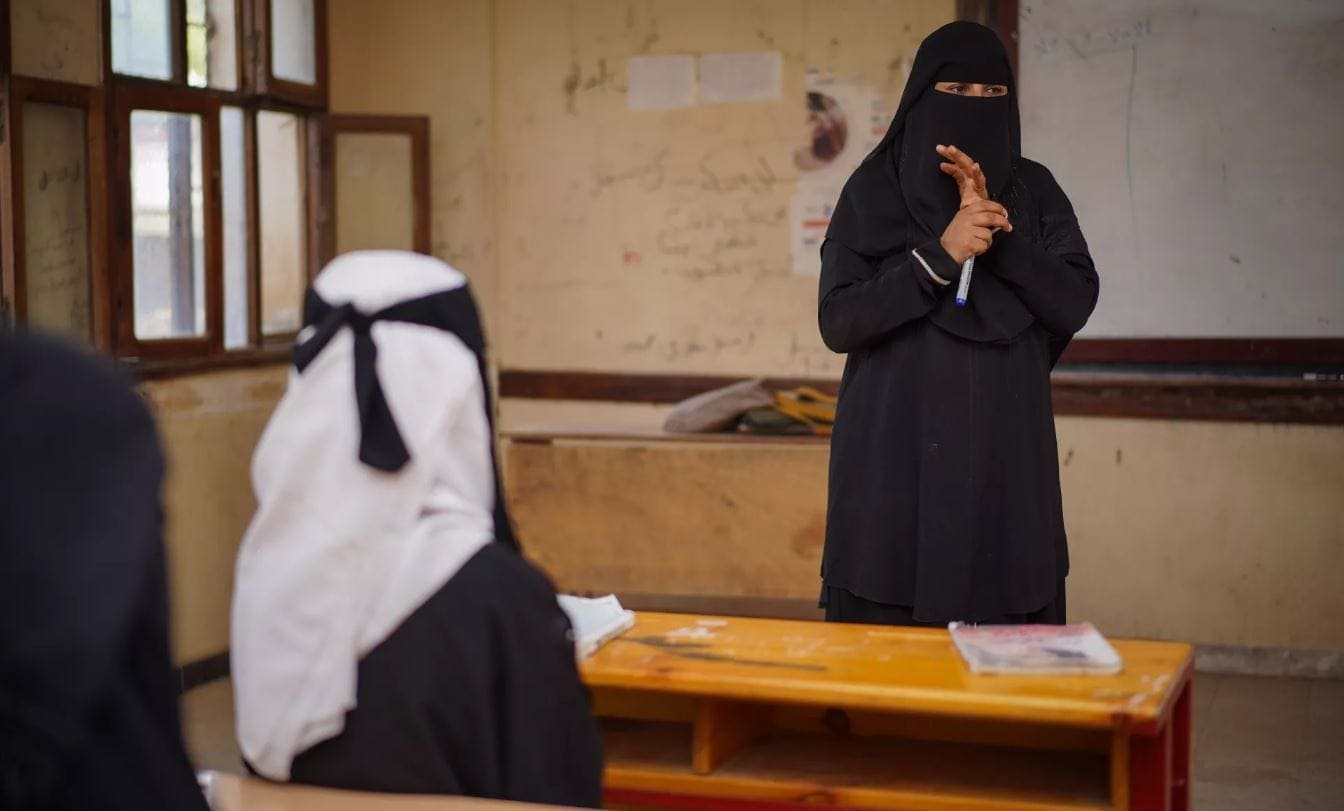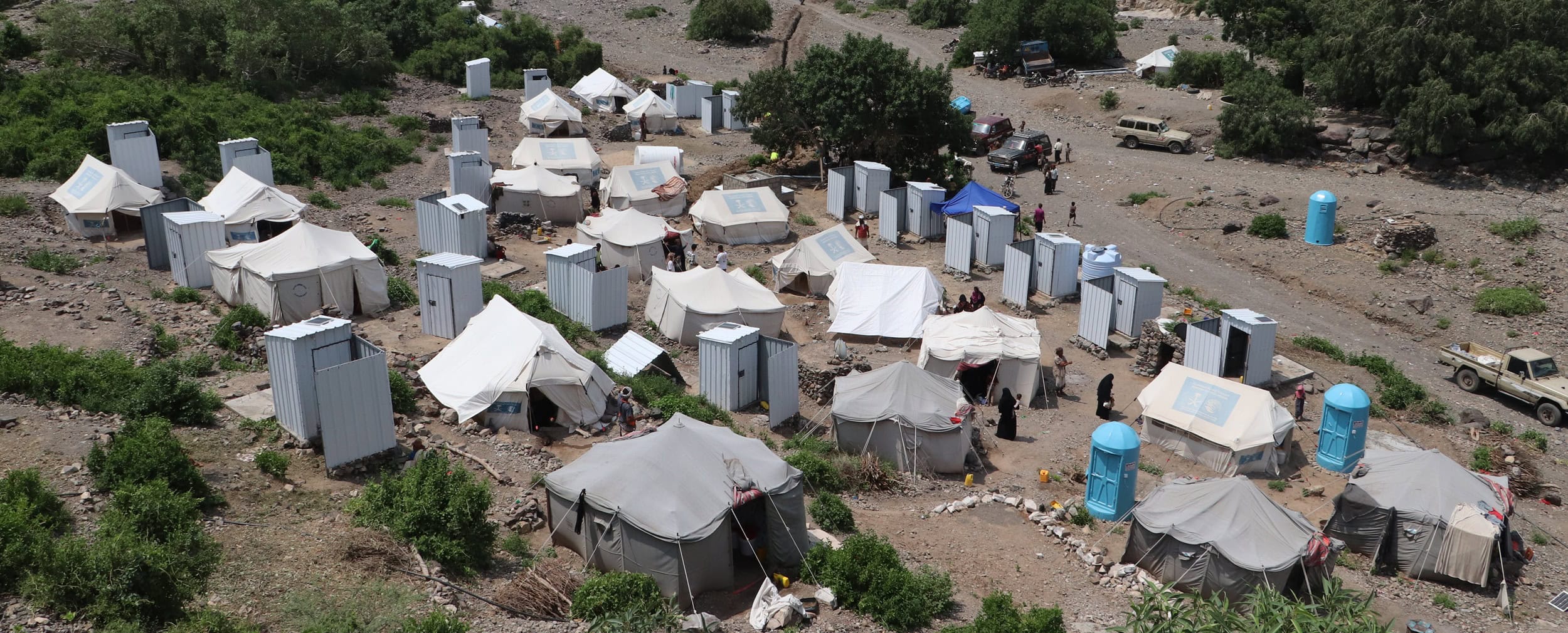
UNICEF/Hayyan
آخر تحديث في: 07-11-2024 الساعة 4 مساءً بتوقيت عدن
'School dropout by girls will increase the rate of illiteracy among females. This means more decline of the society at the social, economic, cultural, and health levels.'
Reem Al-Fadhli (South24)
On October 15, the World celebrated the International Day of Rural Women. This came amid the dire humanitarian conditions being experienced by Yemenis, especially rural women and girls. Depriving rural Yemeni girls and young women of primary and even university education is a social attitude across the governorates without any exceptions, particularly among the tribal or poor communities.
There are interlinked and far-reaching reasons at the economic and social levels behind the school dropouts by rural females. The factors related to poverty come at the forefront of these reasons. They are accompanied by social factors, including unfavorable customs and traditions, and the short-sighted view regarding the importance of educating the girl child. This mix of factors and reasons creates one of the worst realities that deprives girls and young women from accessing education.
Article ’6‘ of Law number 45 of 1992 of the Yemeni Constitution stipulates that education is a long-term developmental human investment and the right of everyone regardless of gender. However, these texts do not reflect the Yemeni reality as the law has failed in making tangible changes on the ground.
Early Marriage
Early marriage is among the reasons for school dropout by young girls in rural Yemen. This inherited destructive social practice has been enhanced by the lack of clear legal texts and regulations criminalizing or limiting it, especially after the legislative amendments that took place after the Yemeni unity in 1990. The latter has established religious explanations imposed by parties within the power structure, leading to the spread of early marriage.
Many cases of early marriage are driven by economic motives related to the desire of rural families to benefit from dowries and get rid of the economic burden of maintaining a girl child, including the education costs. However, there are also social motives that push, even affluent families, to get their girls married at an early age. These include endogamy and marriage related to family genealogy and tribal ties.
Fatima, is a young Yemeni rural woman and a victim of early marriage and school dropout. Her roots go back to a village in the center of Abyan governorate. She told ’South24 Center‘ that her older brothers forced her to drop out of school early. According to her, the death of her father was the main reason as she dropped out one year later when she was a fifth-grade student in an elementary school.
She said: “My mother backed my brothers in forcing me to take such a step. Although I begged her to let me complete my education, she used to tell me that there is no need for it and that I am destined to marry and remain in the house of my husband.”
At 12, Samah left school due to a condition imposed by her then fiancé. Samah, whose roots go to Al-Saeed rural area in Shabwa, told, ’South24 Center‘ that she got married at the age of 15 following a three-year engagement period during which she dropped out of school after being forced by her father to do so as per the demands of her to-be husband’s family.
She pointed out that she married a relative of her mother. Today, Samah, at the age of 18, is a mother of three children, giving birth to them one after the other, after every nine months without getting enough rest. She is currently at an age when students are usually completing the secondary stage of education in Yemen and are at the beginning of university education.
According to a 2021 UNICEF report, “72.5% of girls in Yemen get married while still children (under 18 years)”. It said that “early marriage makes it almost impossible for an adolescent girl to complete her education”.
Economic Reasons
Early marriage isn’t the only problem that girls in rural Yemen face that causes them to drop out of school. The lack of proper infrastructure, such as schools designated for girls, and the shortage of female teaching staff are economic reasons related to the performance of the state, which have contributed to many girls to leave school.
In Shabwa in South Yemen, particularly the rural areas of Al-Masaniah and its suburbs, the number of girls in primary school this year is about 1,600. However, the number of girl students in the secondary education doesn’t exceed 200, according to Salam Hanash, the Head of the Education Office in the governorate, who spoke to ’South24 Center’.
These statistics show the huge gap between the primary and secondary education of rural girls in Yemen. This gap increases at the university level as few girls will likely be able to access this higher education standard. The state-owned University of Shabwa, which was established some years ago, may facilitate the access of girls to university education.
Arwa Ba-Ali, Assistant Principal of the Masaniah Girls School in Shabwa, told ’South24 Center‘ that the hard economic conditions are one of the reasons that have hindered education of girls in the city and its suburbs. She stressed that many girls don’t complete their secondary and university education due to the long distance away from their villages. This is in addition to the lack of universities in the area and the poor financial condition of their families who can't afford the cost of transportation to the city of Ataq, where Shabwa University is located.
Ba-Ali explained that the female graduates from Masaniah School in 2022-23 haven’t completed university education, except for one student. She added that none of the female graduates from the school in 2023-24 have been able to access university.
She explained: “Many 9th grade students graduated from the Khamar School in a village affiliated with Al-Masaniah in 2023-24. However, only five of the female students joined our school this year due to the high transportation costs.”
According to Salam Hanash, the decline in the number of girls who join secondary school in the governorate’s rural areas is mainly attributed to the lack of female teachers. This pushes conservative families to force female students to drop out of secondary school or even earlier as they don’t approve the idea of male teachers in a girls’ school.
The local official pointed out that the lack of female educational staff specializing in teaching rural girls constitutes a big challenge. This is because the customs and traditions require the presence of female teaching staff. Moreover, the lack of separate gender-based classrooms is another main reason, he stressed. This is because the government isn’t very interested in building schools designated for girls or even gender-based separate classrooms within the co-ed schools.
Hanash is looking forward to improving the education of rural girls during the coming period through ongoing efforts to provide female teachers as well as a proper and upgraded educational environment.
In Jahaf in the Southern governorate of Al-Dhalea, whose population number in 2021 stood at 39,413, including 18,541 females and 20,872 males, according to the United Nations Population Fund, the Head of the Education Office in the district Raed Qurei told ’South24 Center‘: “The district and its suburbs face challenges in education infrastructure, especially what is related to educating girls.”
He pointed out that the district has 23 primary schools and five secondary schools and one school that has both phases. Among them, there are only four preparatory schools designated for girls while there are no girls-only secondary schools. He added that Jahaf district has four co-ed secondary schools.
According to him, the number of primary school students at the level of the district is 5,827, including 3,048 boys and 2,779 girls. In the case of secondary education, the number of male students is 1,339 with female students numbering only 552.
Dalal, a rural girl from the district of Shamayatayn in Taiz in North Yemen, dropped out of school after her father became unable to work due to his deteriorating health. Dalal isn’t the only victim of this sad case but her two brothers too dropped out of school.
Dalal said: “I was only two years away from secondary school. My father used to encourage me to be a teacher. However, this dream has vanished in one moment. My pain has been doubled by losing my education career as well as my concerns now of losing my father too.”
The story of Dalal reflects the general poor situation of education in Yemen, especially during the past decade of the ongoing conflict.
Statistics issued by the ’Malala Fund for Girls’ Education‘ show that more than one million Yemeni girls dropped out of school, representing 28% of all school aged girls nationally. It added that the school dropout percentage in the primary stage reached 20%, and 34% in the preparatory stage while it increased to 68% in the secondary level.
The aforementioned ’UNICEF‘ report said that 84.5% of children in Yemen “live in monetary poverty. In the long run, this situation will continue to perpetuate the cycle of poverty”. It added that “poor and vulnerable children and adolescents are also more likely to have never been to school, to drop out of school and to never return to school”.
A study issued by ’Save the Children‘ in 2024 said that “one third of families surveyed in Yemen have at least one child who has dropped out of school in the past two years”. It added that “monthly school fees and the cost of textbooks are putting education out of reach for many, with 20% of families reporting they are unaffordable”.
A July 2024 UN report stresses that “more than 4.5 million Yemeni children did not attend school in 2023, while more than 2,426 schools were damaged and unable to receive students due to their use as shelter or other non-educational purposes”.
The Education of Rural Girls and the Climate
The consequences of climate change in Yemen clearly intersect with the factors that deprive rural girls of education. This highlights this comprehensive crisis which extends to all aspects of life.
Marwa Saleh, Consultant at ‘The Social Fund for Development’ in Hadramout told ’South24 Center‘ that “girls in the villages affiliated with districts such as Sah and Al-Dhaliah often drop out of preparatory schools in order to fetch water for their families. This is due to the drying cement water tanks in these areas.”
The decreasing rain flow and the deterioration of water networks in contrast to the ever-growing population numbers has created a water crisis that is affecting girls and women the hardest. Saleh stressed that many families force girls to drop out of school so that they can fetch water from distant wells and other water sources for their home.
A study issued by ’South24 Center‘ in April 2024 pointed to the health, psychological, economic, and social ramifications of the water crisis in Al-Dhalea. The women and girls who are responsible for bringing water for their families for economic and customary reasons bear the brunt of this crisis. This leads to a large percentage of early marriages and school dropout cases related to this problem
Furthermore, a study issued by ’South24 Center‘ in September 2024 discussed the impact of the climate change crisis on women’s livelihood in Yemen. The study, which is based on field research in Aden, Hadramout and Al-Mahrah, concluded that climate change has created big challenges for women, including leading to decrease of income, rise in the prices of food products, and damage of property.
Professor of Sociology at Taiz University, Dr. Mahmoud Al-Bakari, warns of the dire consequences of school dropout on rural girls and the Yemeni society in general. He told ’South24 Center‘: “School dropout by girls will increase the rate of illiteracy among females. This means more decline of the society at the social, economic, cultural, and health levels.”
He concluded: “Education is the basis of development and progress in any society. The Yemeni rural areas constitute the biggest percentage of the society. Therefore, burdens are increasing by the delay of the development and urbanization process, including achieving educational renaissance.”
Accordingly, it can be said that school dropout by rural girls in Yemen needs an intensified treatment, foremost of which is at the economic level, that will solve many challenges and obstacles, even those that have social and cultural contexts. This treatment may require a comprehensive national program to develop rural education which includes building schools in remote areas and creating more public jobs for female teachers.

قبل 3 أشهر

قبل 3 أشهر